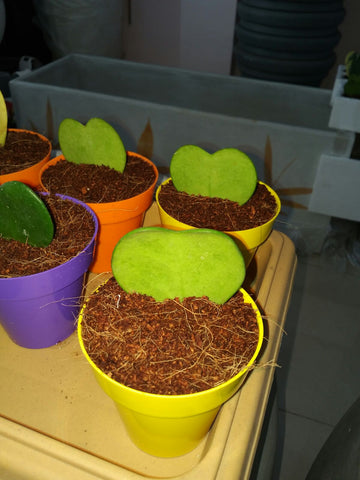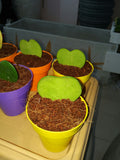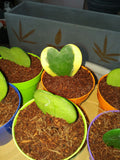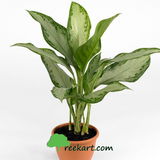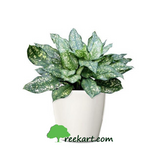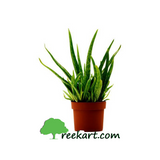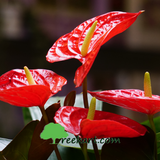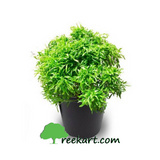Hoya Kerrii (Sweetheart Plant / Valentine Hoya)
There are a few Hoya's out there which make ideal house plants, Hoya kerrii or theSweetheart Plant is one of them. It's become increasingly popular in recent years but you may still struggle to find information or care tips about it.
We have to be fair here and tell you that this plant is a lot like the Lucky Bamboo because most of its recent popularity is based on er, well a fad. Being quite easy to propagate and therefore making it rather cheap to grow and sell on, along with its unusual and quirky "heart" shape leaves, makes it perfect for the marketers to work their magic. This is because it appeals to anyone looking for something a bit odd or for that special novelty gift to give their plant enthusiast friend a chuckle.
The problem is that the Sweetheart Plant today is usually sold as this single small leaf in a small pot much like the Hoya Kerrii from Ikea in the picture above. The difference between this and the Lucky Bamboo is that the Sweetheart Plant in this form is novel for 5 minutes then it's rather boring!
All is not lost because it's easy to spin this negativity around; it's ridiculously easy to look after, potentially letting you get away with only minimal care. It would probably tolerate only one good watering a month it's that hardy. Also if you have that sole leaf long enough and treat it respectfully (or cheat and buy a more mature plant with several leaves already on the go) you will end up with something much more beautiful and striking because the unusual shaped leaves on mass, as you might be able to guess, looks like a bush of green hearts! What a great Valentine gift to give someone, and the reason it sometimes goes by the name Valentine Hoya!
The flowers, like most Hoya's, are stunning as the contrast in the flowering parts are really bold (check out the photos to see what we mean). The all green variety tends to grow more quickly (although it's still slow by most houseplant standards) and is arguably more hardy, but it also comes in a pretty variegated variety.
Hoya Kerrii Care Instructions
Light
This plant will need a reasonably light room in order to actually grow, although it will still get by even if you pick a shadier spot, very dark places need to be avoided though. Sunlight is acceptable too, so in reality you could position it almost anywhere in your home or office.
Watering
With its succulent qualities it's quite adapt at storing water for longish periods of time between watering's. This makes it a hardy and undemanding plant for the most part, of course only providing basic care will result in a surviving rather than thriving plant, so where possible wait until the soil has dried out a little and then water again. This means don't wait long periods between watering's just because you can. Do be careful not to overdo it though! The soil should never be saturated or boggy as this will lead to rotting. Take special care if the pot it comes in has no drainage holes!
Humidity
The Sweetheart Plant isn't bothered about humidity so you needn't be either.
Feeding
Only a little feeding is required if the plant is small or exists as a single leaf, twice a year at most. If you have an older plant or that single leaf is throwing out new shoots you can feed a little more. Even then though you don't need to be doing it more than four times a year. The Sweetheart Plant is not a very heavy feeder.
Temperature
Most temperatures you find indoors are fine. Growth will slow or stop if things get cool so you will need a range of between 18°C - 27°C / 65°F - 80°F for optimal growing temperatures.
Repotting
This subject triggers debate amongst Hoya owners. There are several general schools of thought which boil down to the following "rules" -
- The soil mix must be free draining and not have a great deal of rich organic material.
- Plants in small pots which are root or pot bound are generally more likely to flower (this only applies to mature plants with many leaves).
- No matter the size or age of the plant, if the pot is too small it won't grow to maturity.
- A big pot for just one leaf plants will have a greatly increased possibility of rotting through accidental overwatering.
So breaking all of this down into practical examples:
- Young plants with only one leaf should start to be repotted when there is new growth.
- Young plants with only a few leaves should be repotted every couple of years, moving them up into a slightly bigger container each time.
- Mature plant's with many leaves should be repotted every couple of years at most, moving them up into a slightly bigger container each time.
Speed of Growth
Growth in the early days of a young plant is often slow to get going and when it does eventually start it's still slow. Once it is established however with a good root system "vines" will shoot out quite quickly on which new leaves are formed.
Height / Spread
The most common indoor form these days is a miniature plant but with age and good conditions the plant will clamber over its surroundings and cover quite a large space.
Flowers
On older plants you can expect a wonderful annual display. Blooms often appear in Summer, with numerous small flowers, they contrast in colours so really stand out. 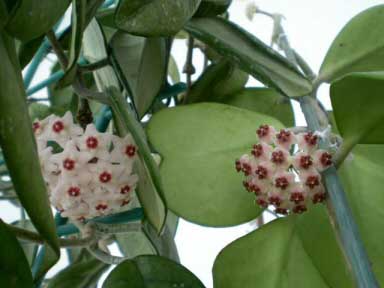
Displayed in a format of a star and it's very usual for a delicate but at the same time powerful perfume to waft from the flowers.
Assuming you have either a young plant with several leaves or a mature one (anyone with just a one leaf plant should bookmark this page and return in a year or two!) chances are you will have noticed the vines that come from deep within the plant. These thicken and stiffen up very quickly eventually making training and bending of these vines almost impossible. The obvious solution is to get the vines trained and into position, perhaps over a small pot trellis, as they are actually growing so you have the exact framework you want from the get go.
The mature vines are grey and tend to feel and look woody. Although most of this stiffness is a result of lignin designed to support a heavy climbing plant (out in their natural habitat they tend to grow up and up), you do still have a limited amount of control in regards to training. If the plant becomes very dehydrated, i.e. it hasn't been watered for some time the vines will lose a small amount of stiffness and will have a degree of flex. It's not much though and careless bending will cause damage, but you can attempt to shape the plant.
We Also Recommend

